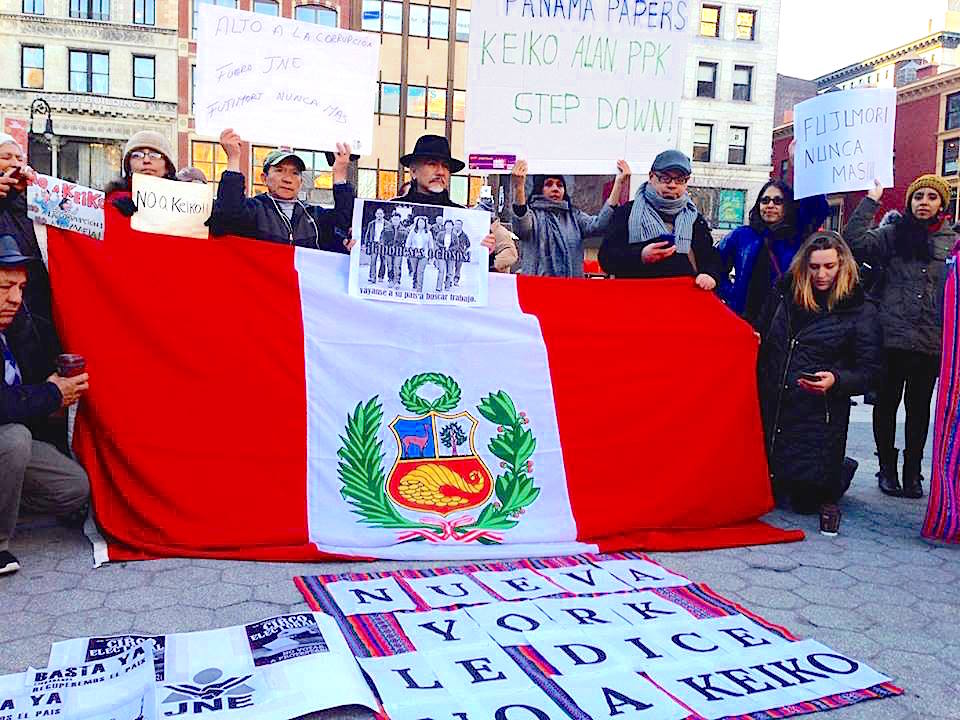
BY BILL WEINBERG | I’ve heard Quechua spoken in the highlands of Peru, but the first time I heard it in my hometown New York was April 5, when some 200 metro-area Peruvians gathered in Union Square. The rally was held in conjunction with a mass mobilization in Peru that day. You know that sinking feeling you’ve experienced witnessing the rise of an ugly oligarch-demagogue over the past year, and facing up to the grim prospect of the provocateur’s potential presidency? Peru has been going through the same thing.
The most prominent banner at Union Square read “NUEVA YORK LE DICE NO A KEIKO” — “New York says no to Keiko.” That’s Peru’s Donald. One sign called Keiko a suway — “thief” in the indigenous language Quechua.
But Keiko Fujimori isn’t the son of a real estate developer. She’s the daughter of an ex-dictator. March organizer Eduardo González-Cueva, an adjunct professor at The New School specializing in human rights, said: “We demonstrate against Keiko Fujimori because her party vindicates the record of human rights violations committed during the dictatorship led by Alberto Fujimori in the 1990s, and their members have made clear that they will release him from prison.”
As we gathered in Union Square, some 100,000 marched in Lima and other Peruvian cities to recall the April 5, 1992 “autogolpe” (“self-coup,” or suspension of civil government) by then-president Alberto Fujimori — and to repudiate the presidential ambitions of his daughter. The mobilization came just as candidate Fujimori was implicated in the “Panama Papers.” The leaks reveal that a top financier of the Fujimori campaign set up offshore accounts through the notorious Panamanian law firm Mossack Fonseca.
González-Cueva clocked a second reason for the protests: “Because fujimorismo is deeply enmeshed in corruption. In fact, its appearance as a political organization is just a varnish for a federation of mafias and local caudillos” — or political bosses.
Alberto Fujimori is in prison for human rights abuses as well as illicit enrichment. His 1993 imposition of authoritarian rule was in response to the Shining Path insurgency. So the Fujimori political agenda (fujimorismo) is a mix of law-and-order populism and an aggressively pro-corporate economic program. Sound familiar?
And González-Cueva gives a third reason: “Because fujimorismo ran in this election with the protection granted by partial electoral authorities.” Two other candidates were stricken from the race after revelations of giving out money at campaign rallies. The exact same charge failed to get Keiko removed.
Six days after the march, the first round in Peru’s race was held. Front-runner Fujimori will now face a mainstream former cabinet minister, Pedro Pablo Kuczynski, in a June runoff — while leftist challenger Veronika Mendoza was bumped out of the race. Sounds pretty similar to what just happened in the New York primary, no?
González-Cueva says the group that came together for the Union Square rally “was an ad hoc, spontaneous coalition of Peruvians” who joined a call he issued through Facebook. He says it represented “several different options, from the Left to the Right.” Participants came mostly from Queens but also Paterson, N.J., Long Island and several parts of the city.
The rally closed with a march around the square, led by a big Peruvian flag in front, and then the singing of the Peruvian national anthem. We can imagine that neither Keiko nor Donald would have been pleased.

















